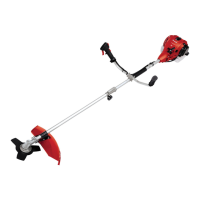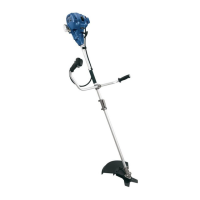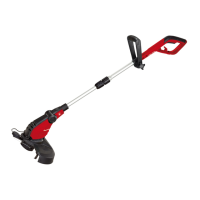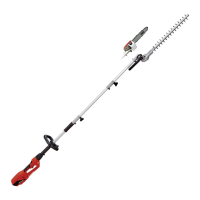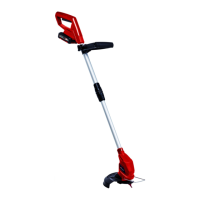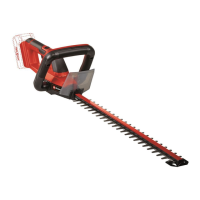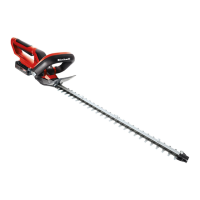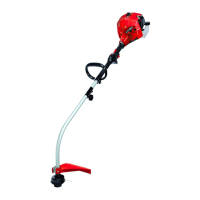GB
- 25 -
le with the line. If, for example, the line strikes
stones, stone walls or foundations, it will wear or
fray.
If the line strikes wire fencing, it will break.
Trimming around trees
When trimming around tree trunks, approach
slowly so that the line does not strike the bark.
Walk around the tree, cutting from left to right. Ap-
proach grass or weeds with the tip of the line and
tilt the line spool forwards slightly. Warning! Take
extreme care during mowing work. When doing
such work keep a distance of 30 meters between
yourself and other people or animals.
Mowing
When mowing, you want to cut all the vegetation
down to the ground. To do this, set the line spool
at an angle of 30° to the right. Place the handle in
the required position. Remember the increased
risk of injury to the user, watchers and animals,
and the danger of damaging property due to ob-
jects (for example stones) being thrown up (Fig.
9e).
Warning! Do not use the equipment to remove
objects from footpaths, etc. The equipment is a
powerful tool and can throw small stones and
other objects a distance of 15 meters or more,
causing injuries and damage to cars, houses and
windows.
Sawing
The equipment is not suitable for sawing.
Jamming
If the cutting blade jams as a result of attempting
to cut vegetation that is too dense, switch off the
engine immediately. Remove the grass and scrub
from the equipment before you restart it.
Preventing recoil
When you work with the blade, there is a risk of
recoil if it strikes solid objects such as tree trunks,
branches, tree stumps, stones or the like. This will
throw the equipment backwards in the direction
opposite to the rotation of the tool. This can cause
you to lose control of the equipment. Do not use
the blade near fences, metal posts, boundary
stones or foundations. For cutting dense stalks,
position the blade as shown in Fig. 9f to prevent
recoil.
9. Maintenance
Always switch off the equipment and pull out the
spark boot plug before carrying out any mainte-
nance work.
9.1 Replacing the line spool/cutting line
1. Dismantle the line spool (13) as described in
section 5.1.6. Press the spool together (Fig.
12a) and remove one half of the housing (Fig.
12b).
2. Take the line spool out of the line spool
housing (Fig. 12c).
3. Remove any remaining cutting line.
4. Place the new cutting line in the center and
attach the resulting loop to the recess in the
spool splitter (Fig. 12d).
5. Wind the line on to the spool counter-clockwi-
se with tension. The spool splitter will separa-
te the two halves of the nylon line (Fig. 12e).
6. Hook the last 15 cm of the two ends of the
line to the line holders opposite the line spool
(Fig. 12f).
7. Thread the two ends of the line through the
metal eyelets in the line spool housing (Fig.
12c).
8. Press the line spool into the line spool
housing.
9. Cut the excess line to a length of around 13
cm. This will reduce the load on the engine
when starting up and warming up.
10. Fit the line spool again. See section 5.1.6. If
you are replacing the complete line spool,
ignore points 3-6.
9.2 Grinding the safety hood blade
The safety hood blade can become blunt over
time. When you notice this, undo the screw hol-
ding the safety hood blade on the safety hood.
Clamp the blade in a vise. Sharpen the blade with
a fl at fi le and make sure that the angle of the cut-
ting edge is not altered in the process. File in one
direction only.
9.3 Maintenance of the air fi lter (Fig. 10a-10c)
Soiled air fi lters reduce the engine output by sup-
ply too little air to the carburetor. Regular checks
are therefore essential. The air fi lter (10) should
be checked after every 25 hours of use and clea-
ned if necessary. If the air contains a lot of dust,
the air fi lter should be checked more frequently.
1. Remove the air fi lter cover (Fig. 10a).
2. Remove the fi lter element (Fig. 10b/10c).
3. Clean the fi lter element by tapping it or
Anl_GC_BC_25_30_AS_SPK1.indb 25Anl_GC_BC_25_30_AS_SPK1.indb 25 21.10.2016 11:59:2821.10.2016 11:59:28
